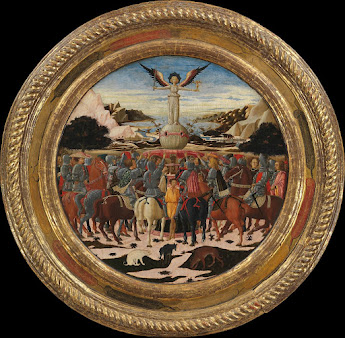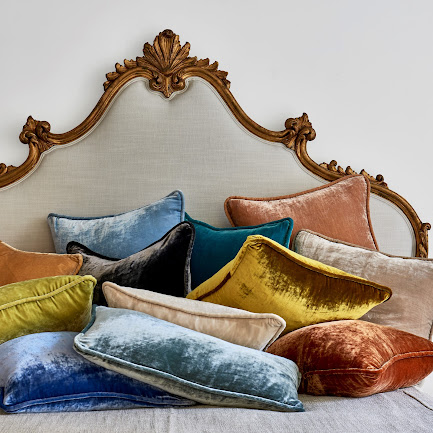TEXTILE DIARIES: The Richness & History of Velvet, A Modern Version- Performance Velvet by root cellar designs
image via Met MuseumTEXTILE DIARIES COLUMN
The Rich History of Velvet,
And, A Cool, Modern Version- Performance Velvet by
root cellar designs
I often look at interior design from different vantage points-- first as, a learned interior designer I entered the industry, then I created this blog and embarked upon an adventure of writing about design which takes me down a lot of fun "rabbit holes" covering topics around this world. Many times over the years, I've written about other designers and artists. Then in 2016, Susan Young and I started our very own textile company catering to the design and home industry. Today, our American-made fabric and wallpaper (root cellar designs), is sold throughout 13 design-trade showrooms and through design reps around the country. These various perspectives gives me some valuable talking points, as well as a deep well of inspiration to tap into on a daily basis. Hence, this column Textile Diaries was born. I relish learning then sharing the "back story" of myriad textiles I have come to love and appreciate over the years. How it's made, where it's sourced and all the great stories in between. Today, let's talk about the luxurious textile, Velvet!
What is Velvet?
Originally, velvet was a fabric created with a pile made of silk threads and made with warps drawn over rods that initially create the loops. Through the weaving process, the looped pile is woven into the fabric structure then the rods are removed and the loops are then cut to a dense pile to what we know as velvet, a smooth (with a slight sheen) cut pile that feels luxurious to the hand and holds a deep color showing lots of light when folded or draped. These unique properties lend itself to why it's one of the most popular textiles in history, and still today considered a luxurious fabric for home and fashion.
Who First Made Velvet?
Velvet goes way back, and some believe all the way back to 2000 BC to the Egyptians who first used the technique on linen. Velvet production has been also traced to Cairo and then to Iraq. But, when the Chinese dynasties became fascinated with making velvet in 200 BC they created it with silk threads, and this is closest to the velvet we know and love today. Many European countries were the first to mass produce this textile and they traded it along the Silk Road. The Europeans took this rich technique and grew a major industry that helped them prosper economically, and today many equate luxurious velvet with European craftsmanship. First in Italy, then Spain, Turkey, Greece and France/England created velvet.
How The Italians Grew It In Popularity?The Italians grew it as a household name (everyone knew of it but only the wealthy could afford it in their home) when the Italian trades built a strong velvet manufacturing industry and controlled the production throughout Europe between the 12th and 18th centuries.The workshops in Venice were thriving in the 1400s when they created a new technique - the Soprarizzo method- in which a double pile is created involving weaving one layer that absorbs light with a lighter layer on top to reflect the light. The new velvet had a wave-like effect that was highly desired by the wealthy class. The Renaissance era was dominated with the lushness of velvet and it can been noted on drapery, upholstery in castles and on royalty clothing with its intricate detailing, patterns and also woven from silk and gold and silver threads. The infamous powerful Medici family controlled the production and grew this textile to be one of the most important fabrics in the world. Artists like Michelangelo and Leonardo da Vinci studied the velvet loom and were commissioned to design the textile with their works for the wealthy families of Europe. It wasn’t until the industrial revolution in the 1890s, when velvet was mass produced, that is lost a bit of the high end cache.
Why Was It A Carefully Guarded Secret?
There was such a strong financial gain for countries in producing velvet that the secrets of creating this textile were a carefully guarded secret, and so much so that many skilled tradesmen and craftsmen were kept inside the city walls near the factory and not allowed to go home in the evenings in order to stop them from sharing these secrets with rival manufacturers. In 1472, Venetians invented patent law to prevent their secrets from leaking.
Today’s Velvet, Performance Velvet
However, just like centuries ago, technology has once again opened up the flood gates for velvet and in the past few years Performance Velvet has grown in popularity in the design industry. A Velvet that feels rich to hand yet can withstand outdoor elements and the wear and tear of modern living seemed unlikely at first, but indoor/outdoor velvet is here to stay and it’s gorgeous.
shop root cellar designs’
To read more in depth about the richness and history of velvet, check out the MET Museum story.Happy NestingXO Tamara
TEXTILE DIARIES COLUMN
The Rich History of Velvet,
And, A Cool, Modern Version- Performance Velvet by
root cellar designs
I often look at interior design from different vantage points-- first as, a learned interior designer I entered the industry, then I created this blog and embarked upon an adventure of writing about design which takes me down a lot of fun "rabbit holes" covering topics around this world. Many times over the years, I've written about other designers and artists. Then in 2016, Susan Young and I started our very own textile company catering to the design and home industry. Today, our American-made fabric and wallpaper (root cellar designs), is sold throughout 13 design-trade showrooms and through design reps around the country. These various perspectives gives me some valuable talking points, as well as a deep well of inspiration to tap into on a daily basis. Hence, this column Textile Diaries was born. I relish learning then sharing the "back story" of myriad textiles I have come to love and appreciate over the years. How it's made, where it's sourced and all the great stories in between. Today, let's talk about the luxurious textile, Velvet!
What is Velvet?
Originally, velvet was a fabric created with a pile made of silk threads and made with warps drawn over rods that initially create the loops. Through the weaving process, the looped pile is woven into the fabric structure then the rods are removed and the loops are then cut to a dense pile to what we know as velvet, a smooth (with a slight sheen) cut pile that feels luxurious to the hand and holds a deep color showing lots of light when folded or draped. These unique properties lend itself to why it's one of the most popular textiles in history, and still today considered a luxurious fabric for home and fashion.
Who First Made Velvet?
Velvet goes way back, and some believe all the way back to 2000 BC to the Egyptians who first used the technique on linen. Velvet production has been also traced to Cairo and then to Iraq. But, when the Chinese dynasties became fascinated with making velvet in 200 BC they created it with silk threads, and this is closest to the velvet we know and love today. Many European countries were the first to mass produce this textile and they traded it along the Silk Road. The Europeans took this rich technique and grew a major industry that helped them prosper economically, and today many equate luxurious velvet with European craftsmanship. First in Italy, then Spain, Turkey, Greece and France/England created velvet.
The Italians grew it as a household name (everyone knew of it but only the wealthy could afford it in their home) when the Italian trades built a strong velvet manufacturing industry and controlled the production throughout Europe between the 12th and 18th centuries.The workshops in Venice were thriving in the 1400s when they created a new technique - the Soprarizzo method- in which a double pile is created involving weaving one layer that absorbs light with a lighter layer on top to reflect the light. The new velvet had a wave-like effect that was highly desired by the wealthy class. The Renaissance era was dominated with the lushness of velvet and it can been noted on drapery, upholstery in castles and on royalty clothing with its intricate detailing, patterns and also woven from silk and gold and silver threads. The infamous powerful Medici family controlled the production and grew this textile to be one of the most important fabrics in the world. Artists like Michelangelo and Leonardo da Vinci studied the velvet loom and were commissioned to design the textile with their works for the wealthy families of Europe. It wasn’t until the industrial revolution in the 1890s, when velvet was mass produced, that is lost a bit of the high end cache.
Why Was It A Carefully Guarded Secret?
There was such a strong financial gain for countries in producing velvet that the secrets of creating this textile were a carefully guarded secret, and so much so that many skilled tradesmen and craftsmen were kept inside the city walls near the factory and not allowed to go home in the evenings in order to stop them from sharing these secrets with rival manufacturers. In 1472, Venetians invented patent law to prevent their secrets from leaking.
Today’s Velvet, Performance Velvet
However, just like centuries ago, technology has once again opened up the flood gates for velvet and in the past few years Performance Velvet has grown in popularity in the design industry. A Velvet that feels rich to hand yet can withstand outdoor elements and the wear and tear of modern living seemed unlikely at first, but indoor/outdoor velvet is here to stay and it’s gorgeous.















